Comment Slack est devenu une plateforme de communication de premier plan
Produits iconiques épisode 003
Slack is only about five years old, but it’s become the fastest-growing SaaS company of all time. 📈
And for good reason: it’s a beautiful communication platform that brings companies together and helps eliminate much of the annoying email clutter that many offices face.
So, how did Slack achieve its meteoric rise to tech fame — from a $0 to a $5 billion valuation in less than 5 years? Let’s break it down and discuss the product a bit more in-depth! 👉
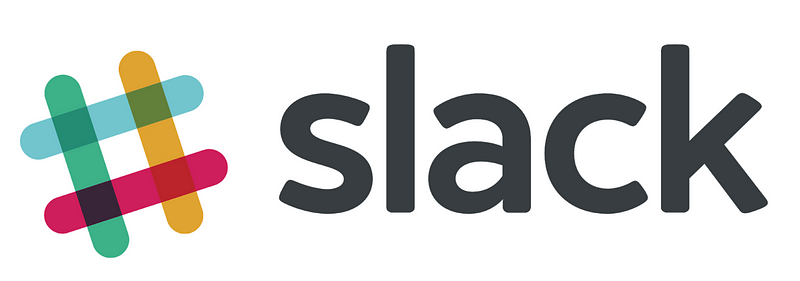
Slack’s incredible growth trajectory
Founded by Cal Henderson and Flickr’s Stewart Butterfield, the communication platform got attention immediately: 8,000 customers signed up for the service within 24 hours of its initial launch in August 2013.
But as you already know, it didn’t stop there. In February 2015, the company claimed that about 10,000 new daily active users were signing up each week, and that they had more than 135,000 paying customers spread across 60,000 teams. 🤝
En avril 2015, ces chiffres étaient passés à 200 000 abonnés payants et à un total de 750 000 utilisateurs actifs quotidiens. Fin 2015, Slack a dépassé le million d'utilisateurs actifs quotidiens.

Et malgré la concurrence dans le monde des plateformes de chat, de produits tels que Facebook for Work, Microsoft Teams et Atlassian HipChat, Slack a dépassé les six millions d'utilisateurs actifs quotidiens et les neuf millions d'utilisateurs hebdomadaires à la fin de l'année 2017.
Fin 2017, plus de 50 000 équipes payaient pour son service, ce qui représente environ deux millions d'utilisateurs payants.
According to Gartner, Slack was one of the first to participate in the business flow collaboration market and remains the leader, with 100% ARR growth (which is incredibly fast for a company of its size) and more than 70% market share in the workstream collaboration space. 🚀
Inutile de dire que Slack est devenu une légende dans le monde du SaaS.

Slack realized something important from the beginning: emails suck
One thing that especially helped Slack become what it is today is the fact that they created the right platform at the right time — and they understood one crucial detail: people hate internal emails. 📬
Cela a ouvert la voie à un produit qui réduirait l'encombrement inutile des boîtes de réception et contribuerait à créer des communautés au sein des entreprises.
It helps with transparency within companies as well — messages that would have normally been emails can just be dropped into a quick message in a channel, so that the team is informed without needing to CC everyone on an endless thread of emails.
According to Slack, users on average spend 10 hours each weekday with the platform open on their desktop and mobile device — that’s a lot of time spent on a chat platform, but that’s the beauty of it: Slack helps you get work done.
While Slack is similar to instant messaging platforms that were popular on the internet years ago, it still helps different departments and teams of a company communicate in real time, rather than having to wait for people to reply to emails or wait for a scheduled meeting (which wastes even more time in the end). ⏳
Slack conserve chaque message dans une archive facilement consultable, et ces messages existent en dehors de votre boîte de réception, ce qui réduit l'encombrement et contribue à atténuer la surcharge de courrier électronique.
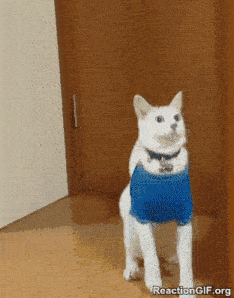
Slack focuses on these three things in order to successfully replace email
One awesome aspect of Slack that helps cement its iconic status is the fact that it’s a beautiful, easy-to-use, well-designed product.
Butterfield a fait appel à l'agence de design MetaLab pour transformer leur premier prototype en un produit abouti que nous connaissons tous et que nous utilisons encore aujourd'hui.
And while MetaLab founder Andrew Wilkinson didn’t even know that Slack would become popular or grow as fast as it has, he explained that, “[like] a well-built home, great software focuses on giving its users hundreds of small, satisfying interactions.” 🏠
Et Slack est certainement à la hauteur sur ce plan, grâce à ses trois aspects fondamentaux : la recherche, la synchronisation et le simple partage de fichiers. Il semble tout simplement bien construit.
Recherche — quite similar to Gmail’s approach, Slack understood the value of their product was in helping people find what they’re looking for quickly.
As Butterfield has pointed out in an interview with Fast Company, “People need to feel confident that when they read a document or conversation, they don’t have to worry about labeling or storing it — that they’ll be able to find it again later if and when they need it.” 👍
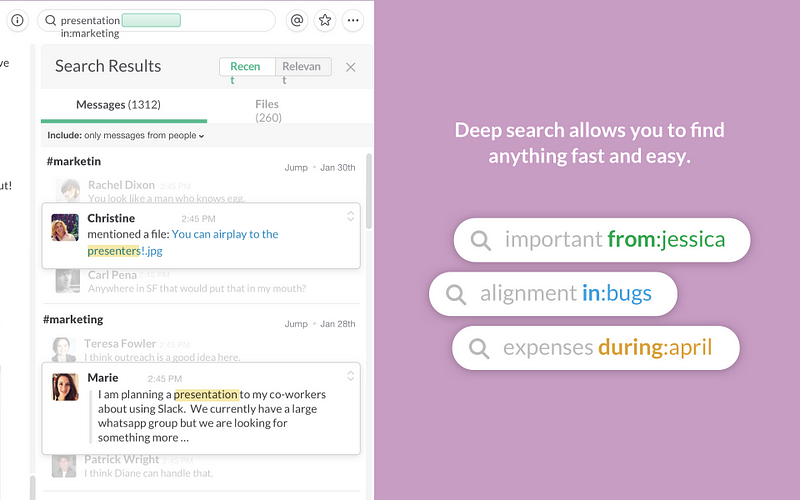
Synchronisation — On synchronization, Butterfield said, “One of the things that drove us nuts about every other internal platform was that it was very difficult to pick up in the same place when you switched devices–say, when you left your laptop and picked something back up on your phone.”
The ability to sync your conversations seamlessly with the desktop and mobile app from the beginning has given Slack the competitive edge — it also knows where every person has left off a conversation, and the product syncs to that position in real time.
If you want to see the gory details of Slack’s notification process, check out the workflow diagram below, which encompasses all the considerations that go into whether to notify a user about a message.
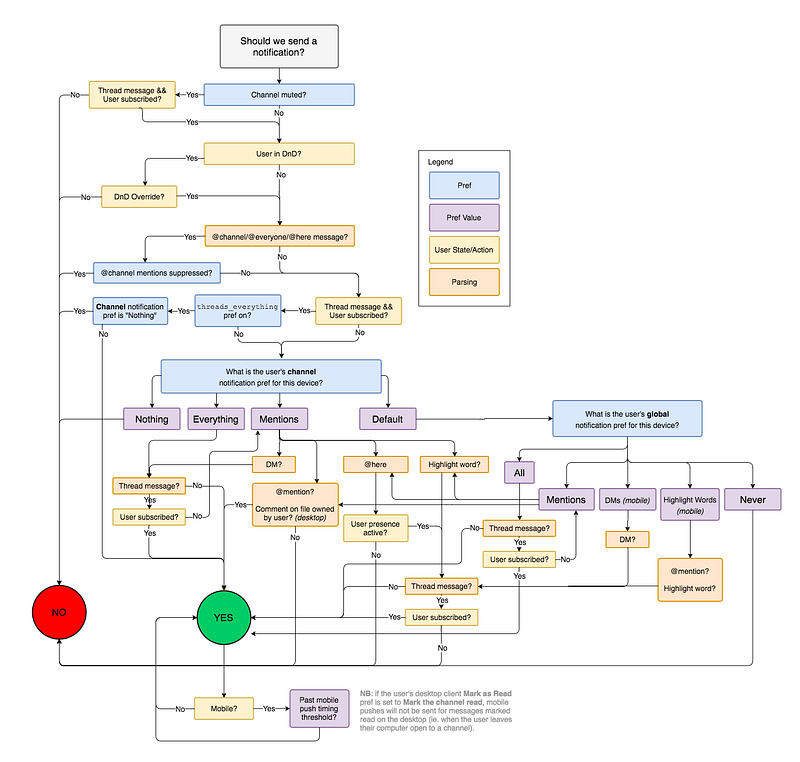
Simple file sharing — Slack is incredibly intuitive in its UI, so it’s natural that they’ve created simple file-sharing options. Slack helps users save time and have a better experience by letting them drag and drop files and paste images directly into the chat.
Unlike email, Slack is built to be fun
From the colorful branding to the funny quotes that pop up on your loading screen — Slack takes every opportunity possible to inject a bit of playfulness into the user experience.
This is especially true in their onboarding process. When you’re waiting for it to load, like the platform itself, it will display funny quotes and at the end of the process, the Slackbot will even make a joke about being “dumb” and “typically understanding words like yes or yup or nope.” 🤖
L'ensemble du processus est très humain et engageant, ce qui favorise le bouche-à-oreille de la part des utilisateurs. Ils montrent le produit, plutôt que de simplement vous en parler.
It’s even fun to the point that it can sometimes feel like you’re, well, slacking. Yet, it’s a tool that helps you collaborate among teammates and get stuff done.

Slack vs. email : plus addictif ou plus ennuyeux ?
According to Growth Hackers, Slack considers the 2,000 message mark to be a critical metric. From the moment someone enters their email address to request a link to a team, the app is designed to drive users to this number. 🔑
But the addictive nature of having a feed isn’t for everyone — there are plenty of examples out there of companies that had self-described nightmarish experiences switching their internal communication to Slack.
There are some people who argue that the feed created more confusion for teams, as conversations would get lost unless you were constantly staying on top of your unread messages (Slack kind of fixed this, to be fair — more on that in a minute).
Slack also felt disorganized for some, which led only to an illusion of transparency. 🙅
Of course, Slack works best if your entire team is actively using it — and if said team is using it in a productive way. It can easily get out of hand if your company doesn’t have an internal communication process in place.
Slack rassemble tout en un seul endroit en développant des intégrations
Slack integrates with just about any app — easily — which also adds value to its users. Especially when it comes to the apps that many companies rely on daily; it just makes Slack more indispensable and a handy means of streamlining in-company communication.
There are tons of integrations out there (Salesflare included, via Zapier!), so it’d be nearly impossible to talk about all of them in one post, but you can integrate, for example, productivity tools such as Asana and Trello, or just fun tools such as Giphy and Meme Bot.
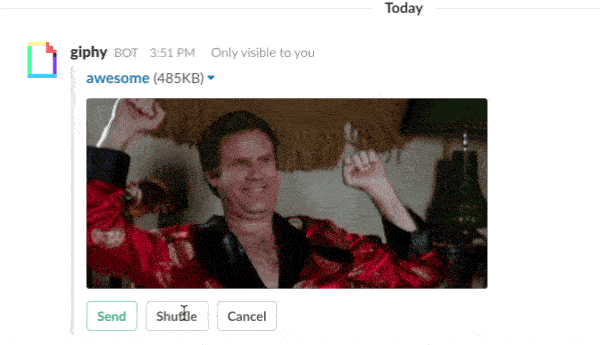
Slack understands that in order to (success)fully replace email, they need to integrate with every app from which their target audience would normally get email notifications. ✅
It also makes Slack indispensable. It’s the place where everything happens. It’s the feed you check almost compulsively.
It makes the possibilities of Slack virtually limitless — and, again, fun!
Slack vise la perfection instantanée
Slack’s design is largely unchanged from MetaLab’s original design, but the features that have been released since then weren’t without lots of testing and iterations.
Prenons l'exemple de Threads : il a fallu près de deux ans à Slack pour explorer cette fonctionnalité avant de la déployer. Et le projet a connu six itérations au cours de cette période ! Les fils de discussion permettent aux utilisateurs de discuter de sujets particuliers dans le cadre de conversations distinctes, ce qui empêche les conversations asynchrones d'encombrer vos canaux.

It’s a feature that really feels like it was built by humans, for humans. That’s something we can definitely get behind at Salesflare. 💛
All of this to say: we’re excited to see Slack continue to grow and change how companies get work done.
Keep nailing it, Slack! 🎉

Vous avez apprécié ? Découvrez d'autres produits emblématiques.
Nous espérons que vous avez apprécié cet article.
Si c'est le cas, passez le mot !
Pour en savoir plus sur les startups, le marketing de croissance et les ventes :
- 22+ Best Sales Podcasts You Should Check Out in 2024 - décembre 21, 2023
- Scripts d'appel à froid pour les êtres humains - 21 septembre 2023
- Les 25+ meilleurs outils de vente pour aider votre équipe à réussir - 10 août 2023
